Curryglass
Houses within 10km of this house
Displaying 41 houses.
Houses within 10km of Curryglass
Displaying 41 houses.
| House name | Description | |
|---|---|---|
| Fort House | The residence of David Hartigan in the early 1850s, held from William and Charles Wyse (minors) and valued at £13. | |
| Drewscourt | Home of the Drew family in the 18th and early 19th century. Drew's Lodge, Charleville, is listed as the residence of F. Drew in 1814 and Lewis refers to Drew's Court as the residence of the Drew family. The house appears to be vacant at the time of Griffith's Valuation and was in the possession of Henry Thomas Allen who held land from Francis Drew. Clennel Frank Massy Drew occupied this house in 1906, valued at £18. Drewscourt was burnt down in the 1920s but the farmyard complex remains. |
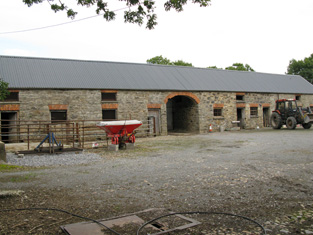
|
| Rossmore | Rossmore was the home of the Shelton family in the 18th and 19th centuries, occupied by J. Shelton in 1814 and 1837. The Reverend Grantley Shelton was resident in the early 1850s. The house was held from the Conyers family and was valued at £25. In 1894 Slater refers to it as the residence of Deane Shelton. | |
| Castletown Conyers | The seat of the Conyers family, occupied by C. Conyers in the early 19th century. By the time of Griffith's Valuation the house appears to be in use as an auxiliary workhouse, held by the Croom Guardians from William Bailey, medical doctor, and valued at £25. In 1894 it was the residence of Charles Conyers. |

|
| Kilmurry | A house valued at £11 and held by Eyre Lloyd in fee at the time of Griffith's Valuation, now derelict. |
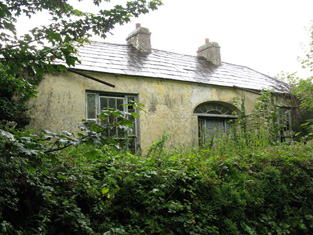
|
| Creggane Castle | A property associated with the Hutchins family, occupied by John Quaid at the time of Griffith's Valuation and held from Samuel Hutchins. The buildings were valued at £17. The sale rental 1857 records that the original lease dated 1802 was from Edmund Earl of Cork and Orrery to Emanuel Hutchins. Farm buildings occupy the site. | |
| Churchtown House | Located on the Egmont estate Churchtown House was the residence of the Crofts family in the 18th and early 19th centuries. Occupied by George Crofts in 1814 and by the Reverend F.W. Crofts in 1837. By the time of Griffith's Valuation it was owned by Sir Edward Tierney in fee and valued at £44. Later 19th century occupants were Major Trench and John Cowhey. This house is still extant and occupied. |

|
| Tullylease | Hajba writes that the Morgans [Morgells] had an interest in this house through marriage with the Sullivans. Occupied by John Sullivan in 1814 and partly rebuilt by William Sullivan in the 1830s. Occupied by William Sullivan in the early 1850s and held from the representatives of Crosbie Morgel, when it was valued at £15.15 shillings. Acquired by James Lynch at the end of the 19th century and restored by the present owners. |
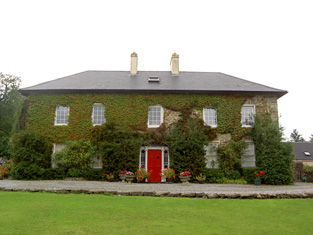
|
| Gubleagh House | The buildings at Gubleagh House, Annagh South were valued at £13 at the time of Griffith's Valuation and the house was occupied by Johanna Cowhy who held it and 189 acres from Sir Edward Tierney. This house is still occupied. | |
| Burton Park | The original house built by Sir John Perceval and his descendants was burnt down in the Jacobite War 1689-1691. A late Georgian house was built to replace it by the [3rd or 4th] Earl of Egmont which was remodelled in the late 19th century. Burton Park was leased to the Purcells in the 19th century. It was occupied by the Reverend Matthew Purcell in 1814 and 1837 and by his son John in the early 1850s when the house was valued at £34. Passed to the Ryans of Scarteen, county Limerick by marriage in the early 20th century. In the 1940s the Irish Tourist Association Survey noted Burton Park as one of the best examples of eighteenth century domestic architecture in county Cork. Still the home of the Ryan Purcell family. |

|
| Clashganniv | Hajba writes that this house has always been the home of the O'Brien family. Vincent O'Brien, the famous Irish race horse trainer, was born at Clashganniv in 1917. The house is still extant and occupied. At the time of Griffith's Valuation there were two houses in Clashganniv, one valued at £16, was occupied by James Lynch and the other valued at £10 was held in fee by Sir Edward Tierney. | |
| Creggannacourty | Cregane House in Creggannacourty was occupied by the representatives of Sarah Barry and held from Sir Edward Tierney at the time of Griffith's Valuation, when the house was valued at £35. Hajba associates the names Crofts, Hennessy and Hutchins with the house, which in 2002 was the home of the Lynch family. |

|
| Rath | Smith writes in 1750 that Rath was built by Alderman James French of Cork. Rath house was occupied by Michael Greene in the early 1850s and held from Sir Edward Tierney. It was valued at £12. To the north Rath Cottage (Grid Ref R492 147) was held by Sir Edward Tierney in fee and was valued at £14. This cottage is now a ruin and Rath House although still extant is no longer lived in, a new house having been built on the site. | |
| Egmont House | An early Perceval house situated at Egmont was replaced by the present house in the 18th century. At the time of Griffith's Valuation John Bolster was occupying Egmont House on the Egmont estate. The buildings were valued at £15. Later leased to the Lynch family. The house is extant and under refurbishment in recent years. |

|
| Egmont Lodge | A house was in existence at this location at the time of the first Ordnance Survey but is not named on the map. By the time of Griffith's Valuation it was valued at £14 and occupied by Bartholomew W. Purdon. It is labelled Egmont Lodge on the 25-inch Ordnance Survey map of the 1890s. A house is still extant at the site. |

|
| Egmont Cottage | Egmont Cottage is marked on the first Ordnance Survey map circa 1840. It was the single storied residence of Margaret Magrath in the early 1850s. She held the property from the Earl of Egmont and the buildings were valued at £10. The building has since been extended and is still occupied. Hajba calls this house Egmont Lodge. |

|
| Fort Moylan | Home of the Moylan family on the Egmont estate, occupied by Cornelius Moylan at the time of Griffith's Valuation when the buildings were valued at £10. Still extant and occupied |

|
| Baily Ville | Situated on the Neville estate this house was built by the Baily family in the mid 19th century. It is marked on the first Ordnance Survey map, circa 1840. By the 1870s Richard Gregg was living in the house which was then known as Oakville. He owned 405 acres in county Cork. Hajba writes that Gregg sold his interest in the property to the Fitzpatricks in the 1880s and this family was still in residence in the early 21st century. | |
| Cooliney House | Hajba writes that Cooliney was originally part of the Bowerman estate and that the house was rebuilt in the mid 18th century. It passed through marriage to the Nevilles of Furnass, county Kildare. Occupied by Mr Thomas Weldon in 1814 and by R. Weldon in 1837. At the time of Griffith's Valuation Robert Weldon held the house and 85 acres from James Hill. The house was valued at £20. In the 1940s the Irish Tourist Association survey noted that it was then the home of the Goold family. The house was restored in the 21st century. |
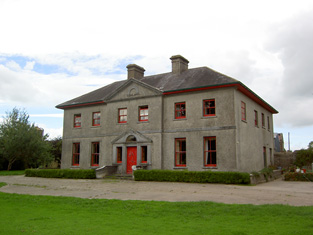
|
| Milltown Castle | Originally the home of Thomas Evans, a younger brother of the 1st Baron Carbery, and of his son Eyre Evans. Mary, sister of Eyre Evans, married George Bruce in the mid 18th century. The Castle was subsequently leased by the Evans to the Bruces and it remained the home of the Bruces until the late 19th century. Described by Lewis as “a handsome castellated mansion in the later English style”. Reduced in size in the early 20th century. The Irish Tourist Association Survey of the 1940s noted that the buildings, at that time the residence of the Keane family, were not in good repair. However, the building continues to be occupied. |
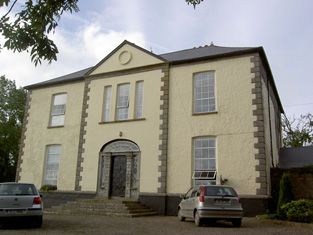
|
| Fortwilliam | A house on the Evans estate occupied by William Barry at the time of Griffith's Valuation when it was valued at £23, later a Sheehy residence. The Sheehy sale rental of 1875 records the house containing 3 reception rooms and 5 bedrooms. It was conveyed to Robert K. Sheehy by Edward R. C. Barry on 7 January 1874 and advertised for sale in June 1875. The National Inventory of Architectural Heritage dates this Tudor Revival house from circa 1880 to the design of Sir John Jackson (1851-1919), so the present house may incorporate the earlier one which is marked on the first Ordnance Survey map. In 2006 this house was no longer occupied. |
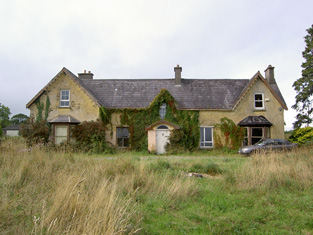
|
| Kilbolane | Home of the Barry family in the late 18th and 19th centuries located on the Evans estate. Occupied by Edward Robert Caulfield Barry in the early 1850s when the house was valued at £39. There was also a flour mill closeby. Sold by the Barrys at the end of the 19th century to David O'Leary Hannigan and later purchased by Milford Creamery who demolished the house in the mid 20th century. |
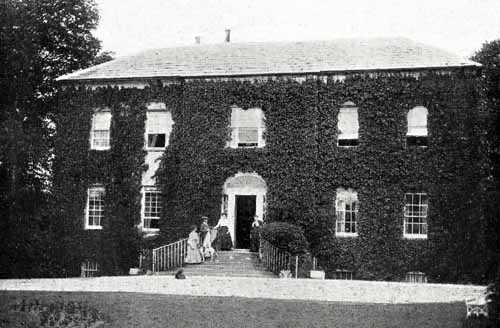
|
| Prohust | Prohust/Prohurst/Proughis was built by Jonathon Bruce, third son of the Reverend Jonathon Bruce of Milltown Castle, and occupied by him in 1837. By the time of Griffith's Valuation the property was held by George and John Evans in fee, the buildings were valued at £37. Hajba writes that the house was occupied by members of the Turner and Rice families in the latter half of the 19th century. This house is still occupied. |
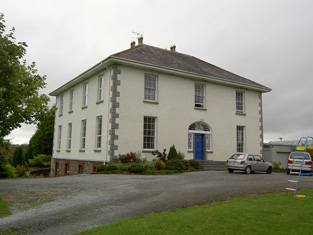
|
| Gibbings Grove | This house was the seat of the Gibbings family in the 18th and early 19th centuries. The family was still resident in 1837 but by the early 1850s the house was occupied by Edmond Irwin who held it form Richard Gibbons. It was valued at £14. Later occupants were local priests and it was eventually sold by the Gibbings in the late 19th century. In 1944 the Irish Tourist Association Survey referred to it as the home of the Cagney family who had purchased the property c.1912 and also that it was famous for growing the Toormore apple, used in making cider. The house is still occupied. |

|
| Castle Ishen | Castle Ishen was the seat of the Fitzgerald family from the mid 17th century until the late 19th century. In the late 18th century the castle was replaced by the house which stands today. In the 19th century the house was occupied by the estate agents, members of the Hannigan and O'Leary families although Lady Fitzgerald, widow of the 8th Baronet, is recorded as the occupier at the time of Griffith's Valuation. She held the house valued at £10+ in fee. Her sons were both minors at the time. Hajba writes that the O'Learys purchased the house in the early 20th century. In 1944 the Irish Tourist Association Survey noted that they had first come there in the 1790s. Castle Ishen is still extant. | |
| Hardingville House | Home of the Harding family in the 19th century, occupied by C. Harding in 1837 and by William Harding in the early 1850s. The Hardings held the property from James D'Arcy Evans and the buildings were valued at £11.15 shillings. The Hardings also occupied Hardingville Cottage another residence in the same townland, Grid Reference R403 217. In the 1870s William Harding of Coolnagour owned 229 acres in county Cork. The house is no longer occupied. |
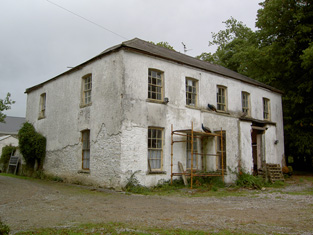
|
| Altamira | Originally a Smyth house, Altamira became the home of the Purcell family in the late 18th century and remained in their possession for about a century. Occupied by William Purcell in 1814 and 1837 and by his nephew Pierce Purcell at the time of Griffith's Valuation. Pierce held the property from the Earl of Bandon and Lady O'Brien. The house was valued at £34. In the 1940s the Irish Tourist Association Survey noted that Altamira was then the residence of the Hannigan family. |
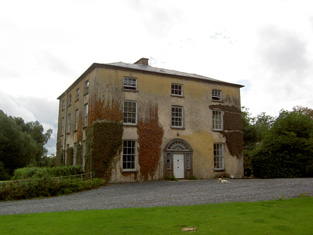
|
| Belfort | Originally a Reeves home, occupied by them in 1837, it became the residence of the Clanchy family in the mid 19th century. John Clanchy was resident at the time of Griffith's Valuation when the house was valued at £21 and held with 37 acres from the representatives of John B. Reeves. The Irish Tourist Association Survey of the 1940s refers to it as the residence of Mrs. Clanchy, widow of J.T. Clanchy and noted that it was much associated with horseracing. Bence Jones records the demolition of this house in 1958. | |
| Aughrim | A home of a branch of the Goold family occupied by George Goold in the early 1850s and held from Henry V. Wrixon. The buildings were valued at £13.10 shillings. George Goold still lived here in the 1870s. The house is occupied. | |
| Teeveeny House | A house valued at £14 held by Michael Cagney from Richard and Jonas Morris in the mid 19th century. His widow Johanna Cagney was still resident in the 1870s. In 1943 the Irish Tourist Association Survey reported that the house had was then occupied by the Condron family. Buildings are still extant at the site. | |
| Moyge | Richard Boles was granted Moyge in 1666. Sir Bernard Burke records the Boles of Devon as still having an interest in Moyge in 1850. At the time of Griffith's Valuation Maurice Newman [Nunan] was the occupier holding the property from the Earl of Bandon. The buildings were valued at £10. 10 shillings. This house no longer exists. | |
| Fortlands | Fortlands was occupied by members of the Batwell family in the first half of the 19th century. Hajba writes that the Batwells held the property from the Hutchins family. By the mid 19th century Samuel Hutchins was occupying the house, held by him in fee and valued at £31+. The home of the O'Connor family in the 20th century. The original house does not appear to be extant. | |
| Highfort | The Purcells originally lived in a thatched house located a short distance from the present building and this house was associated with a Whiteboy attack. John Purcell was knighted for his defense of his property. The later house was built by his son, Dr. Richard Purcell, circa 1837 and Dr Richard's wife, Mrs Eliza Purcell, was resident in the early 1850s when the house was valued at £21+ and held from Pierce Purcell. Mrs Eliza Purcell was the second daughter of Pierce Purcell of Altimira. Occupied by Daniel Stephen Wigmore in the early 20th century. The Irish Tourist Association Survey of the 1940s noted that it was then the residence of the O'Sullivan family. It is no longer extant. | |
| Sanders Park | Late 18th century house, the seat of the Sanders family, occupied by William Saunders in 1814 and by C. Saunders in 1837. Griffith's Valuation records William R. Saunders holding the property from the Earl of Cork, the buildings were valued at £34+. The Irish Tourist Association Survey of the 1940s stated that it was then the residence of Mr. Binchy, a merchant in Charleville. It was converted into flats in the latter half of the 20th century but the building was derelict at the beginning of the 21st century. Also known as Charleville Park. |
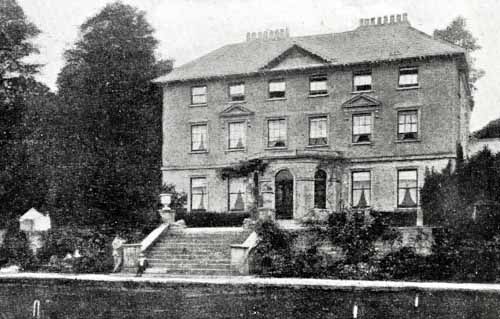
|
| Newtown | Hajba dates this house from 1749 when it was built as a hunting lodge for the Courtenays. Described by Lewis in 1837 as the seat of Robert Courtney, John Culhane was resident by the time of Griffith's Valuation, holding the property from John Courtnay. The buildings were valued at £13. In 1943 the Irish Tourist Association Survey noted that it was then the home of the Culhane family. The house was demolished in the 1960s. | |
| Gortskagh | No house of more than £5 valuation is recorded in Griffith's Valuation in Gortskagh except the glebe house at £26. This house was occupied by Reverend William Bunbury who held the property from John Courtenay. The Deane connection with Gortskagh commenced with the marriage in 1871 of Honourable Matthew J.H.F. Deane, uncle of the 4th Baron Muskerry, with Maria, daughter of Reverend William Bunbury. The Deanes sold the house to the Binchy family in the 1890s. Home of the Foley family in the early 21st century. |
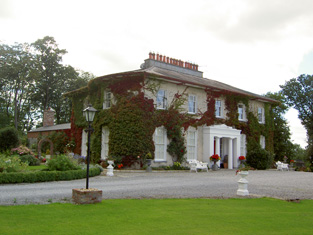
|
| Springfort | Dating from the very early 18th century, Springfort was the home of the Vowell family in the 18th century but Mr Cox is recorded as the proprietor in the late 1770s. By 1837 the Reverend Jonathan Bruce was resident. In the early 1850s William Carroll occupied the house holding the property from William Cox. The buildings were valued at £11+. This house was still extant in the 1980s when it was the home of the Cagneys. | |
| Farm Hill | In the mid 19th century occupied by Mrs Hannah Goold, valued at £13 and held from Richard and Jonas Morris. This house is marked on the first Ordnance Survey map and a building is still located at the site. | |
| Moatville | Located on the outskirts of Charleville this house was occupied by Mrs Ryan in 1837 and of Michael Ryan at the time of Griffith's Valuation. Moatville was later the birthplace of Dr Reeves, Bishop of Down, Connor and Dromore. In the 1940s the Irish Tourist Association Survey described it as "a quaint high house, the residence of Mr. Ball". It is still extant. |

|
| Glenview Cottage | In 1786 Wilson refers to a house in the vicinity of Egmont as "Glenfield", the seat of Mr. Wrixon. This may be the property marked on the 1st edition Ordnance Survey map as Glenview Cottage. At the time of Griffith's Valuation, this house was leased by Daniel Murphy from the Egmont estate and valued at £10. A house is still extant at the site. | |
| Holmesfort | In the 1940s the Irish Tourist Association survey notes that a house at Shinanagh, parish of Imphrick, was occupied by Major Thomas Holmes in the early nineteenth century and known as Holmesfort. It was replaced in the 1830s by another house, built by an O'Connor family. By the 1940s it had become the home of the O'Regan family. A house and farm buildings are still extant at the site. |

